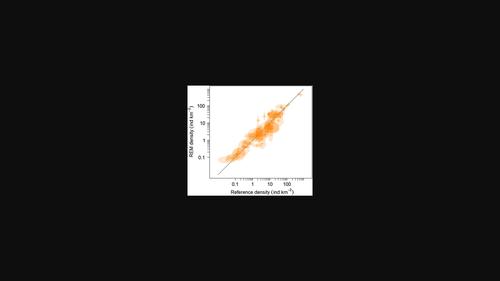当前位置:
X-MOL 学术
›
Remote Sens. Ecol. Conserv.
›
论文详情
Our official English website, www.x-mol.net, welcomes your
feedback! (Note: you will need to create a separate account there.)
Random encounter model is a reliable method for estimating population density of multiple species using camera traps
Remote Sensing in Ecology and Conservation ( IF 3.9 ) Pub Date : 2022-06-24 , DOI: 10.1002/rse2.269 Pablo Palencia 1 , Patricia Barroso 1 , Joaquín Vicente 1 , Tim R. Hofmeester 2 , Javier Ferreres 1 , Pelayo Acevedo 1
Remote Sensing in Ecology and Conservation ( IF 3.9 ) Pub Date : 2022-06-24 , DOI: 10.1002/rse2.269 Pablo Palencia 1 , Patricia Barroso 1 , Joaquín Vicente 1 , Tim R. Hofmeester 2 , Javier Ferreres 1 , Pelayo Acevedo 1
Affiliation

|
Population density estimates are important for wildlife conservation and management. Several camera trapping-based methods for estimating densities have been developed, one of which, the random encounter model (REM), has been widely applied due to its practical advantages such as no need for species-specific study design. Nevertheless, most of the studies in which REM has been assessed against referenced methods have sampled one population, precluding evaluation of the circumstances under which REM does or does not perform well. At this point, a review of all REM assessments could be useful to provide an overview of method reliability and highlight the main factors determining REM performance. Here we used a combination of literature review and empirical study to compare the performance of REM with independent methods. We reviewed 34 studies where REM was applied to 45 species, reporting 77 REM-reference density comparisons; and we also sampled 13 populations (ungulates and lagomorphs) in which we assessed REM performance against independent densities. The results suggested that appropriate procedures to estimate REM parameters (namely day range, detection zone and encounter rate) are mandatory to obtain unbiased densities. Deficient estimates of day range and encounter rate lead to an overestimation of density, while deficient estimates of detection zone conducted to underestimations. Finally, the precision achieved by REM was lower than reference methods, mainly because of the high levels of spatial aggregation observed in natural populations. In this situation, simulation-based results suggest that c. 60 camera placements should be sampled to achieve acceptable precision (i.e. coefficient of variation below 0.20). The wide range of situations and scenarios included in this study allow us to conclude that REM is a reliable method for estimating wildlife population density when using appropriate estimates of REM parameters and sampling designs. Overall, these results pave the way to wider application of REM for monitoring terrestrial mammals.
中文翻译:

随机遭遇模型是使用相机陷阱估计多个物种种群密度的可靠方法
种群密度估计对于野生动物保护和管理很重要。已经开发了几种基于相机捕获的密度估计方法,其中一种随机遭遇模型(REM)由于其不需要特定物种的研究设计等实际优势而被广泛应用。然而,大多数根据参考方法评估 REM 的研究都对一个人群进行了抽样,排除了对 REM 表现良好或表现不佳的情况的评估。此时,对所有 REM 评估的回顾可能有助于概述方法可靠性并突出确定 REM 性能的主要因素。在这里,我们结合文献回顾和实证研究来比较 REM 与独立方法的性能。我们回顾了 REM 应用于 45 个物种的 34 项研究,报告了 77 个 REM 参考密度比较;我们还对 13 个种群(有蹄类动物和兔形动物)进行了抽样,在这些种群中,我们针对独立密度评估了 REM 性能。结果表明,估计 REM 参数(即日范围、探测区和遭遇率)的适当程序对于获得无偏密度是强制性的。对日范围和遭遇率的估计不足会导致对密度的高估,而对探测区的估计不足会导致低估。最后,REM 实现的精度低于参考方法,主要是因为在自然种群中观察到的高水平空间聚集。在这种情况下,基于模拟的结果表明 c. 应采样 60 个摄像机位置以达到可接受的精度(即变异系数低于 0.20)。本研究中包含的广泛情况和情景使我们能够得出结论,当使用适当的 REM 参数估计和抽样设计时,REM 是估计野生动物种群密度的可靠方法。总体而言,这些结果为更广泛地应用 REM 监测陆地哺乳动物铺平了道路。
更新日期:2022-06-24
中文翻译:

随机遭遇模型是使用相机陷阱估计多个物种种群密度的可靠方法
种群密度估计对于野生动物保护和管理很重要。已经开发了几种基于相机捕获的密度估计方法,其中一种随机遭遇模型(REM)由于其不需要特定物种的研究设计等实际优势而被广泛应用。然而,大多数根据参考方法评估 REM 的研究都对一个人群进行了抽样,排除了对 REM 表现良好或表现不佳的情况的评估。此时,对所有 REM 评估的回顾可能有助于概述方法可靠性并突出确定 REM 性能的主要因素。在这里,我们结合文献回顾和实证研究来比较 REM 与独立方法的性能。我们回顾了 REM 应用于 45 个物种的 34 项研究,报告了 77 个 REM 参考密度比较;我们还对 13 个种群(有蹄类动物和兔形动物)进行了抽样,在这些种群中,我们针对独立密度评估了 REM 性能。结果表明,估计 REM 参数(即日范围、探测区和遭遇率)的适当程序对于获得无偏密度是强制性的。对日范围和遭遇率的估计不足会导致对密度的高估,而对探测区的估计不足会导致低估。最后,REM 实现的精度低于参考方法,主要是因为在自然种群中观察到的高水平空间聚集。在这种情况下,基于模拟的结果表明 c. 应采样 60 个摄像机位置以达到可接受的精度(即变异系数低于 0.20)。本研究中包含的广泛情况和情景使我们能够得出结论,当使用适当的 REM 参数估计和抽样设计时,REM 是估计野生动物种群密度的可靠方法。总体而言,这些结果为更广泛地应用 REM 监测陆地哺乳动物铺平了道路。











































 京公网安备 11010802027423号
京公网安备 11010802027423号